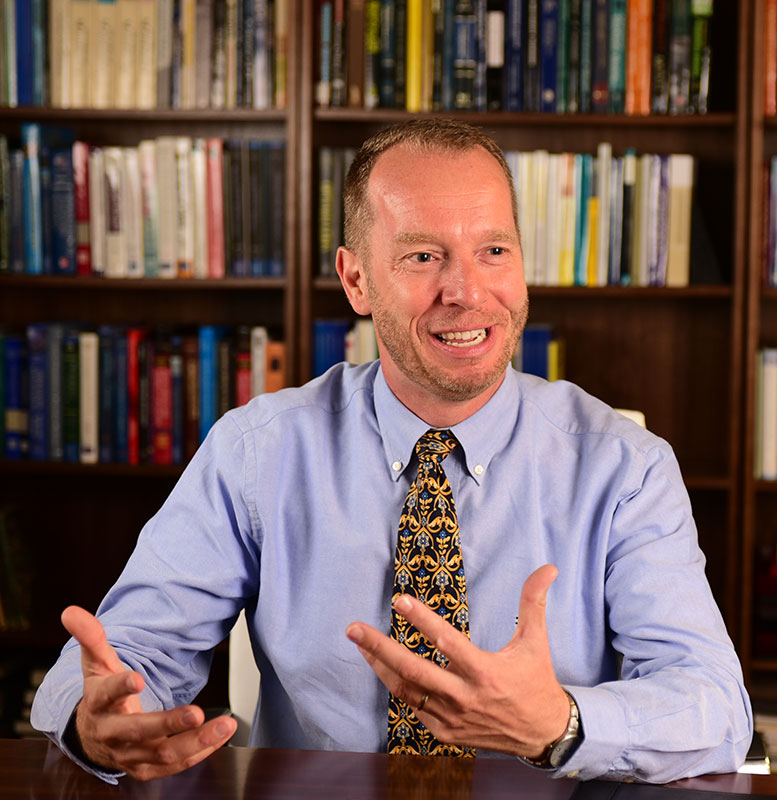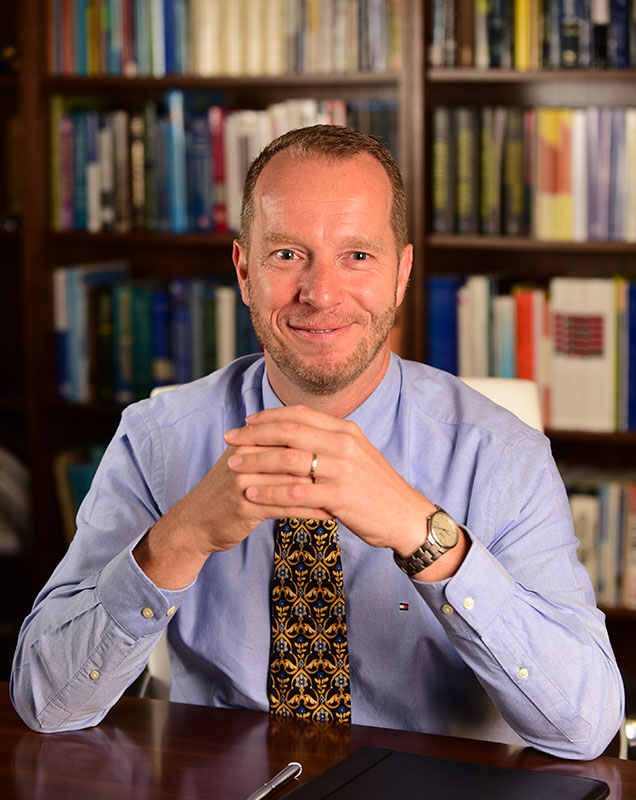H. Edwin Romeijn took the helm as ISyE’s H. Milton and Carolyn J. Stewart School Chair in January 2015, making him the eighth school chair in ISyE’s history.
“Edwin has a unique blend of research expertise, teaching excellence, and national leadership that makes him well suited to expand ISyE’s tradition of excellence and leadership in research and education and to keep the program at the forefront internationally,” said College of Engineering Dean Gary May.
Prior to joining ISyE, Romeijn was the program director for Service Enterprise Systems, Manufacturing Enterprise Systems, and Operations Research at the National Science Foundation in Arlington, Virginia, and Richard C. Wilson Faculty Scholar in the Department of Industrial and Operations Engineering at the University of Michigan. He received his M.S. in econometrics and his Ph.D. in operations research from Erasmus University Rotterdam in the Netherlands in 1988 and 1992, respectively.
Recently, I sat with Dr. Romeijn to chat with him about his vision, leadership, and what it is like to oversee a school consistently ranked the No. 1 industrial engineering program in both graduate and undergraduate education. -- Barbara Christopher
What piqued your interest in becoming ISyE’s school chair?
Honestly, I did not have a career-long goal of going the administrative route. I used to view myself as a career researcher. Over time, I became more interested in looking at a bigger, more strategic view of our field. This came up for me, partly, due to my time as a program director at the National Science Foundation. At that time, I thought if the right opportunity came along I would be interested in taking on a larger administrative role. And by right opportunity, I meant finding something that had a combination of a strong program — a unique potential due to its history, environment, faculty, and student population — someplace close to my heart, and a place where I could contribute something.
When ISyE approached me, it qualified in all areas. ISyE has a long-standing reputation as the No. 1 program in both undergraduate and graduate studies, as well as having top-notch research programs. I was impressed with the size of the program, but mostly its diversity in both theory and application in optimization, statistics, manufacturing, supply chain, health care, energy, you name it. I was excited that my research has touched on a lot of the existing research groups in ISyE. That really spoke to me.
And being a part of Georgia Tech, one of the best technical institutes in the country — if not the world — creates unique opportunities for interdisciplinary research, which is important for all disciplines but especially for industrial and systems engineering.
I’ve been with ISyE for just under a year now, and I can say it is a great place to work.
What are you responsible for as ISyE’s school chair?
Generally speaking, I am responsible for creating and maintaining a healthy environment in which students, faculty, and staff can thrive and be the best that they can be.
As part of your job as chair, you also meet and work with a lot of our alumni. How has that been so far?
Meeting with our alumni is one of my favorite parts of my job. They have been and continue to be instrumental in maintaining the success of ISyE through their involvement on the advisory board, student mentoring and other volunteering activities, as well as through their generous philanthropy.
I had the honor to meet the H. Milton Stewart family before I officially started this position and was impressed with their hospitality and dedication to ISyE. Since then I have gotten to meet many of our alumni, and I look forward to meeting many more. I continue to learn the history and culture of this remarkable school through their eyes.
What are some of the traits of a good leader that you strive to embody?
There are two different yet intertwined traits that I work toward — to be a good listener and to communicate clearly. It’s important to make sure that everyone feels heard, that their opinion matters, and their input is, at the very least, being considered. However, not everyone can get their way each time. While my goal is to build consensus as much as possible, sometimes it will be necessary to make decisions when there is no consensus. At the end of the day, I will always make a decision that I believe is for the good of the School as a whole and will work to communicate why a particular decision has been made.
How do you take a school that has had a long successful run as No. 1 and expand its tradition of excellence to have greater influence?
At the core is the faculty. To a large extent they dictate any new directions or changes within the School. The chair cannot single-handedly decide the direction of the School. A chair suggests, points, and helps coordinate groups of faculty so that synergies are explored and exploited, but at the end of the day it should be the faculty who provides the new ideas. They are the true experts in the different fields of specialization. It is the faculty who will make sure we remain leaders in the field and the No. 1 program.
What is hot in ISyE at the moment?
Analytics is a hot topic, of course. While ISyE can contribute to all three branches of analytics — descriptive, predictive, and prescriptive — it can play a particularly unique role when it comes to prescriptive analytics, i.e., in decision-making. In a way, ISyE has been dealing with problems related to this area for a long time. Yet with the explosion of different types of data available in recent years, there is a need for more and new modeling, statistical, and operations research methodologies. It is exciting that the field is facing problems that we could not conceive of five to 10 years ago, before this kind of data was available. The area of supply chains and logistics is seeing a reinvigoration, with new focus areas such as the Physical Internet and hyperconnected optimization. Areas such as health and humanitarian logistics, energy, and sustainability have been active areas in ISyE for some time but can only be expected to grow in importance in coming years. And with the advent of smart manufacturing, ISyE is poised to expand its role in the area of manufacturing as well.
What do you think are the keys to success?
Having passion and enthusiasm for what you do.
Students often ask me: What should I write my Ph.D. thesis about? What topics should I study to maximize my chances of a good position in five years?
I tell them to pick a topic that really excites them. If they are excited about the topic, most likely they will work hard and be successful at what they do. More often than not, having passion and enthusiasm for the work you do will take you a long way.
What are some current opportunities for ISyE?
There are several opportunities open to us. ISyE has been No. 1 for a long time and has an excellent reputation in a lot of areas. Part of this is because we have great researchers. Part of it is because we have a large program. As a group we are doing fantastic work, but I’d like to see us further increase our leadership to the field as a whole. After all, it is the responsibility of the No. 1 school to do this.
Also, I’d like to see more bridges built and synergies exploited between the various research groups. This is an ideal time to come together and think harder about ways to work across platforms to drive our impact to greater heights. ISyE has a great group of researchers with so many great opportunities to be a front runner in some important upcoming areas.
Currently, we have a large number of undergraduate students. Our challenge there is to make sure we maintain the quality of the undergraduate program despite its growing size. But this is a challenge we are happy to face.
We have high-quality incoming students, and our outgoing students are in very high demand. Employers are scooping them up as soon as they graduate. So both the input and output is quite healthy, and we are dedicated to preserving and improving the quality of the program.
Tell me a little about your research.
My research has been on analytics and optimization theory and applications, in particular in the area of supply chain optimization and optimization in healthcare. I started off more in the area of theoretical optimization, development, and analysis of algorithms. Then I moved to add the area of applied or application-driven research to my work.
On the supply chain optimization side, the problems I work on are more theoretical and motivated by problems that can or may occur in practice but not necessarily following from collaborations with industry.
On the health care side, my work is much more practical. I work closely with radiation oncologists and medical physicists in developing new models and algorithms for finding optimal treatment plans for cancer patients.
How do you balance your research with the administration side of ISyE?
Now that has been a bit of a challenge over the last nine months. As time goes on and I get more fully acclimated, I hope to get more active on the research side again.
You have taught classes in operations research, stochastics processes, applied probability and statistics, supply chain management, and decision support systems. Can you tell me a little about how you teach?
When I teach a class, I always try to set it up in such a way that I encourage the students to actively think along. I want a dialogue with the students, not just a one-way street. I am not interested in the students learning by heart; I’m interested in them learning how things work. This way, they learn intuition behind things and how to approach problems in practice. That is the ideal situation for me.
What brought you to the U.S.?
I started my Ph.D. in 1988 in The Netherlands. At that time, quite a few Ph.D. students in The Netherlands spent part of their research time at top schools in the United States. I was fortunate to have the opportunity to spend a significant amount of my Ph.D. student years at the University of Michigan. After graduation, I received a grant from the Netherlands Organisation for Scientific Research [the Dutch counterpart of NSF] to spend a year as a postdoctoral fellow at Columbia University. I enjoyed the academic environment in the U.S.; it not only allows for a great deal of independence, but the tenure-track system is unique in that it rewards merit, motivation, and hard work.
And on the more personal side, what is your idea of a perfect day outside of work?
It’s relatively simple, really. My wife, Sylvia, and I like to go outside, whether it is for a walk in the park, a bike ride, or to eat lunch or dinner. We also enjoy home remodeling activities, which has been our hobby for the last few years. Between Michigan and Florida, we remodeled several houses together. I like to do the demolition. Sylvia enjoys painting. And we both can install kitchens, flooring, etc. Neither of us can do the real construction work so we called in contractors for those.

